Penny for Your Thoughts
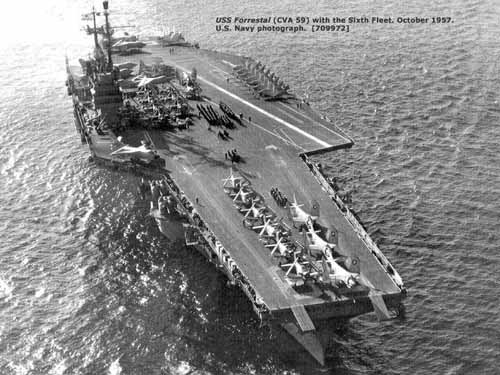
(USS Forrestal (CV-59) on her first Med deployment in 1957. Photo USN).
They did it- sold her for scrap. The ignominy of the transaction- the price- is what got me. The famous warship and my former home- the First Supercarrier- was sold for a penny.
Ex-USS Forrestal (CV-59) went for a sliver of copper amalgam: $0.01
No one wanted her for a memorial ship. I know she was not loved the same way other ships were. Ex-Midway is almost universally beloved by birdfarm sailors, part because of her quirks and part because she lived overseas for the latter portion of her active life, and was home to the Navy’s Foreign Legion, home-ported in Yokosuka, Japan.
That love carried over to enough enthusiasm that a foundation inked a deal with the Navy to take custody of the Maru and tow her down from the INACSHIPFAC at Bremerton to a place of honor in San Diego Bay. She is a popular tourist attraction now, and doing well.
Not all memorial ships work out that way. Poor old ex-Olympia, Dewey’s flagship at Manila Bay, is constantly on the verge of sinking at her berth in Philadelphia, a national embarrassment. So, taking on the mission of preserving a huge chunk of steel that is attempting, successfully, to return to its native state of iron oxide is a daunting one.
No one cares enough about FID to take it on, and now the All Star Metals Company of of Brownsville, TX, has handed over the penny to the Navy Comptroller and will tow FID- “First in Defense,” for the tortured genius James V. Forrestal, first Secretary of Defense- from Philly down to the Gulf and cut her to pieces.
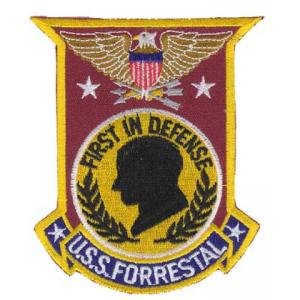
It is a big deal. These massive ships were designed to take a beating and stay afloat, even in the nuclear environment. The hulk measures- or measured before bits began to be cut off- 1,067-foot length overall and 159-foot 4 inches on her beam.
When they cut up jolly old ex-USS Coral Sea, it was the largest scrapping in maritime history. I watched her slowly disappear at the Seawitch shipyard in Baltimore between 1993 and 2000 when the last chuck of steel disappeared and CV-43 was gone forever.
See, capital ships by law must be scrapped in the United States, and when the Seawitch people tried to sell Coral Sea to the Chinese the Navy brought suit. New regulations on the environment have made sinking them expensive, too, though they blew the bottom out of the O-Boat when her time came to become a sport fishing reef down in the Gulf. So, a penny to get rid of her, and the deed is done.
We used to joke about our ships becoming razor blades, in time, and it looks like that is FID’s fate.
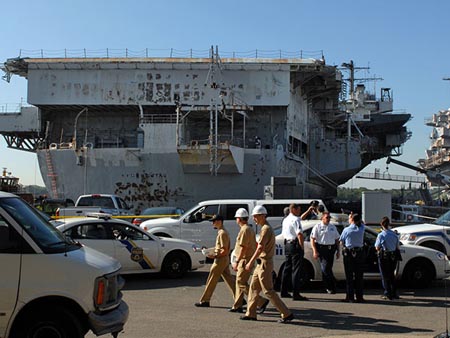
(Ex-USS Forrestal was offered as a museum but found no takers. It will be towed from Philadelphia to Texas for dismantling. PhotoTom Gralish)
There is a lot of valuable material that is not steel on a modern warship. For exercise during deployment (and when the deck was closed for flight ops) I would skip rope in the hangar bay, looking out at the wine dark sea and enjoying the numbness of the ropes repetitions. Prominently posted was an ornate and solemn piece of brass, engraved with the particulars of the 134 sailors who died that awful day on Yankee Station in the Gulf of Tonkin.
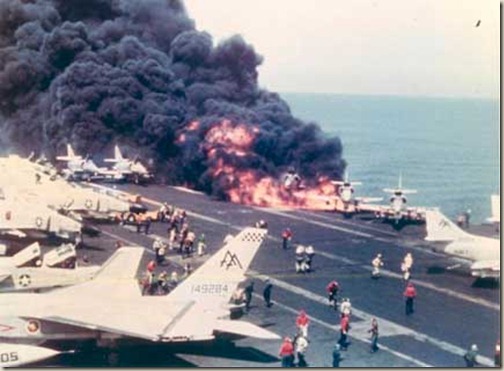
(The Forrestal fire, 1967, on Yankee Station. Photo USN).
You may have heard of the story. LCDR John McCain was sitting in his A-4 Scooter when an electrical malfunction on a nearby F-4 Phantom cooked off and hit the aircraft next to him, starting a blaze that culminated in the detonation of ordnance prepared for the morning’s Alpha Strike against North Vietnam.
I told you these ships were built tough. Although an additional 161 men were injured in the conflagration, FID kept steaming. She gained another nick-name that day: Forest Fire.
The whole thing seemed long ago, steaming in the peaceful Med as the Soviet Union melted down. I hope they will respect the memory of those shipmates who perished, and preserved the plaque.
On that cruise, 1989-90, I lived up on the O-2 level forward, around frame 32. That was right under where the terrible fire occurred. It was there that I found another memorial to a long-ago war.
Now, you know that alcohol is mostly illegal on Navy ships, thanks to that prim old kill-joy Josephus Daniels who banned it in 1914, a dark day in the Fleet. Well, there are times and there are times. On my first ship, the prohibition was flouted openly. The medium attack squadron- VA-115- had a reefer filled with beer in the Junior Officer bunkroom, and our squadron Maintenance Officer Mr. Sluggo had a saying that “if they expect me to fly at night, I expect to have a scotch when I get back.”
They say the little safes in the stateroom desks were sized the way they were to accommodate a bottle of Johnny Walker.
Times were changing. By the time I got to FID in the late 80’s, there was still alcohol around, but you had to be careful. One mid-cruise party in one of the fighter squadron bunkrooms was sniffed out by the Master At Arms, and the squadron skipper was relieved for cause.
I happened to be going ashore when I saw him, eyes downcast and in civvies to make his way to the airport and a lonely flight home.
Anyway, my stateroom was located directly under the flight deck- the catapult track formed the side to one of the bulkheads , and the graceful curve of the bow arched out, leaving a space that could not be utilized by the rectangular modular issue furniture. That left a void partly covered up with sheet metal panels, painted gray, of course, and I was looking for potential places of concealment during the work-up periods at sea as we prepared to deploy.
I noticed one section in which the rivets had been replaced by screws, and as an enterprising Naval Officer, I applied the screwdriver blade on my Leatherman all-in-one tool that I wore on my woven cloth khaki belt. The screws came off easily enough to reveal a deep square space that was filled with objects that had obviously been there a very long time, since the surface was completely covered in black grime.
The shapes looked familiar. I reached in and pulled one out. The side facing down on the can was still pristine, and I read the familiar logo with wonder:
“Budweiser
Lager Beer”
The can had a pull-top, which for you kids means that there was a little ring that pulled up and detached from the can, leaving a drinking slot for the cold foamy beverage to cascade down a thirsty throat. That feature dated the beer to the Vietnam era. The hairs went up on the back of my neck. I wondered if the stash belonged to one of the officers who perished that awful day?
No aviator worth his salt would have gone on a combat cruise and let a case of Bud go to waste.
I reverently placed the can, dirty side up, back in the space with its mates and screwed the metal panel back on. I wondered whose rack I was sleeping in, there by the cat track.
When they start cutting off the flight deck, those cans will be exposed to light again for the first time in 23 years, and nearly 45 since that unknown Airdale hid them away.
That will be my contribution to FID’s memorial. That, and thinking about all those who served- and the ones who died- on that immense ship of steel.
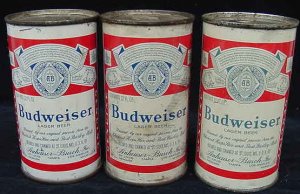
Copyright 2013 Vic Socotra
www.vicsocotra.com
Twitter: @jayare303
